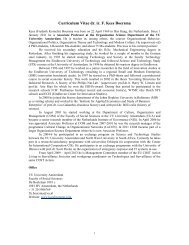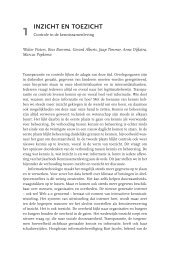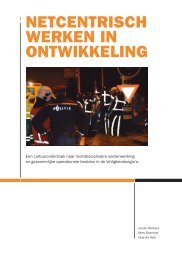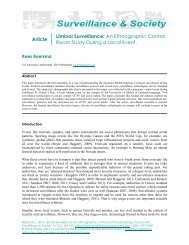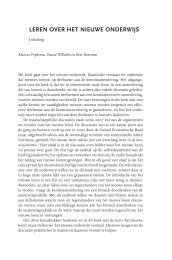Access article in PDF - Project MUSE - Johns Hopkins University
Access article in PDF - Project MUSE - Johns Hopkins University
Access article in PDF - Project MUSE - Johns Hopkins University
You also want an ePaper? Increase the reach of your titles
YUMPU automatically turns print PDFs into web optimized ePapers that Google loves.
92 BOERSMA<br />
Bouwers’s scientific and technological success was <strong>in</strong>sufficient;<br />
over the course of time he was expected to resolve organizational<br />
and f<strong>in</strong>ancial problems as well as technological ones. This caused<br />
tensions <strong>in</strong> the Physics Laboratory, as Holst tried to reduce risks.<br />
Bouwers, however, <strong>in</strong>sisted on his <strong>in</strong>tellectual freedom and sought<br />
the support of Anton Philips, even if this <strong>in</strong>volved go<strong>in</strong>g beh<strong>in</strong>d the<br />
back of Holst, his immediate superior. 85 Anton turned out to be fully<br />
prepared to offer the support Bouwers needed. Together they managed<br />
to push through this loss-mak<strong>in</strong>g activity, bas<strong>in</strong>g their outlook<br />
on the usefulness of X-ray technology on personal expectations.<br />
With this support, Bouwers’s X-ray work at Philips cont<strong>in</strong>ued<br />
and, over the years, ga<strong>in</strong>ed a certa<strong>in</strong> momentum. Aided by the Metalix<br />
pr<strong>in</strong>ciple, Bouwers’s researchers developed further X-ray appliances<br />
<strong>in</strong> the 1920s for specific uses, for <strong>in</strong>stance by dentists, and<br />
several new k<strong>in</strong>ds of X-ray tubes <strong>in</strong> the 1930s. 86 Bouwers’s creativity<br />
was reflected <strong>in</strong> a new discovery <strong>in</strong> early 1930, when he applied for<br />
a patent for an X-ray tube with a metal discharge space constructed<br />
along the l<strong>in</strong>es of the Metalix tube but with a rotat<strong>in</strong>g anode with<br />
bear<strong>in</strong>gs and known as the Rotalix. As early as 1898 a researcher<br />
named Breton had described the notion of a rotat<strong>in</strong>g anode, but no<br />
one had ever successfully commercialized the pr<strong>in</strong>ciple. 87 Comb<strong>in</strong><strong>in</strong>g<br />
the pr<strong>in</strong>ciples of the Metalix tube and the revolv<strong>in</strong>g anode represented<br />
a major step forward. 88 The rotat<strong>in</strong>g anode lessened potential<br />
for damage by excessive heat, because newly cooled sections of the<br />
anode kept mov<strong>in</strong>g under the beam of electrodes. The new system<br />
also made sharper images possible. 89<br />
The Rotalix was well received by customers, <strong>in</strong>clud<strong>in</strong>g doctors<br />
who used it for lung X-rays. Van der Plaats used this tube for his<br />
85. Blanken, <strong>in</strong> History of Philips Electronics, ma<strong>in</strong>ta<strong>in</strong>s that these reasons for<br />
pursu<strong>in</strong>g research probably became known only <strong>in</strong> the early 1930s. Until then,<br />
Anton Philips had not expressed these reasons <strong>in</strong> so many words.<br />
86. Wim Hondius Bold<strong>in</strong>gh, De Geschiedenis van Philips’ Röntgen [The History<br />
of Philips X-ray Research] (E<strong>in</strong>dhoven, 1975), PCA <strong>in</strong>ternal manuscript.<br />
87. J. H. van der Tuuk, “De Rotalix-buis voor Röntgendiagnostiek” [The Rotalix<br />
tube <strong>in</strong> Radiological Diagnosis], <strong>in</strong> Philips Technisch Tijdschrift 3, nr. 10<br />
(1938): 297.<br />
88. Like the Metalix, the Rotalix became known worldwide; see Brachner, et<br />
al., Röntgenstrahlen Zum 100, 70; J. H. van der Tuuk, “Röntgenbuizen met<br />
draaiende anode” [X-ray tubes with revolv<strong>in</strong>g anodes], <strong>in</strong> Philips Technisch Tijdschrift<br />
8, nr. 2 (1946).<br />
89. A. Daan, affiliated with the Physics Laboratory for a number of years <strong>in</strong><br />
his capacity as doctor, elucidated this <strong>in</strong> an <strong>article</strong> published <strong>in</strong> 1929 entitled<br />
“Over de betekenis van de röntgenbuis met draaiend anode voor de longröntgenographie”<br />
[The Significance of the X-ray Tube with a Revolv<strong>in</strong>g Anode for Lung<br />
Radiography], a lecture given to the Dutch Society of Physicians Specialised <strong>in</strong><br />
Tuberculosis.




